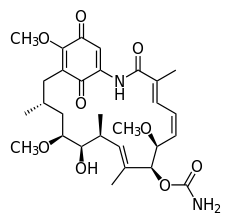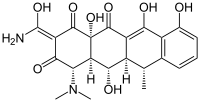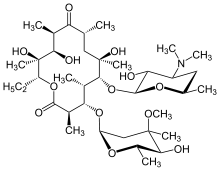Polyketide
Polyketides are a class of secondary metabolites produced by certain living organisms in order to impart to them some survival advantage. These are structurally complex organic compounds that are often highly active biologically. Many pharmaceuticals are derived from or inspired by polyketides.
- Polyketides
-

Geldanamycin, a useful antibiotic.
-

Doxycycline, another important antibiotic.
-

Erythromycin, an antibiotic.
-
-Aflatoxin_B1_Structural_Formulae_V.1.svg.png)
Aflatoxin B1 one of the most carcinogenic compounds known.
Biosynthesis
Polyketides are usually biosynthesized through the decarboxylative condensation of malonyl-CoA derived extender units in a similar process to fatty acid synthesis (a Claisen condensation). [1] The polyketide chains produced by a minimal polyketide synthase are often further derivitized and modified into bioactive natural products.
Polyketides are structurally a very diverse family of natural products with diverse biological activities and pharmacological properties.[2] They are broadly divided into three classes: type I polyketides (often macrolides produced by multimodular megasynthases), type II polyketides (often aromatic molecules produced by the iterative action of dissociated enzymes), and type III polyketides (often small aromatic molecules produced by fungal species). Polyketide antibiotics, antifungals, cytostatics, anticholesteremic, antiparasitics, coccidiostats, animal growth promoters and natural insecticides are in commercial use.
Examples
- Macrolides
- Pikromycin, the first isolated macrolide (1951[3])
- The antibiotics erythromycin A, clarithromycin, and azithromycin
- The antihelminthics avermectin and ivermectin
- The insecticide spinosad (spinosyn)
- Ansamycins
- The antitumor agents geldanamycin and macbecin,
- The antibiotic rifamycin
- Polyenes
- The antifungals amphotericin, nystatin and pimaricin
- Polyethers
- The antibiotic monensin
- Tetracyclines
- The antibiotic agent doxycycline
- Acetogenins
- bullatacin
- squamocin
- molvizarin
- uvaricin
- annonacin
- Others
- The immunosuppressants tacrolimus (FK506) (a calcineurin inhibitor) and sirolimus (rapamycin) (a mTOR inhibitor)
- Radicicol and the pochonin family (HSP90 inhibitors)
- The cholesterol lowering agent lovastatin
- Discodermolide
- Aflatoxin
- Usnic acid
- Anthracimycin
- Anthramycin
See also
| Wikimedia Commons has media related to Polyketides. |
References
- ↑ Robinson JA (1991). "Polyketide synthase complexes: their structure and function in antibiotic biosynthesis". Philos Trans R Soc Lond B Biol Sci. 332 (1263): 107–114. doi:10.1098/rstb.1991.0038. PMID 1678529.
- ↑ Katz, Leonard (1997). "Manipulation of Modular Polyketide Synthases". Chem. Rev 97: 2557–2576. doi:10.1021/cr960025.
- ↑ Brockmann, H. and Henkel, W. (1951). "Pikromycin, ein bitter schmeckendes Antibioticum aus Actinomyceten". ntibiotica aus Actinomyceten, 84: 184–288. doi:10.1002/cber.19510840306.